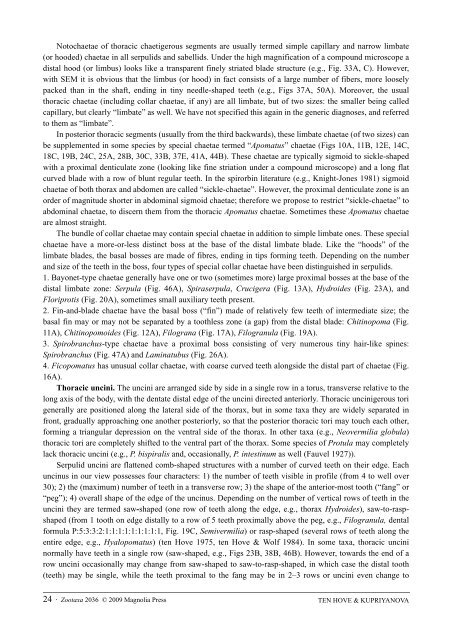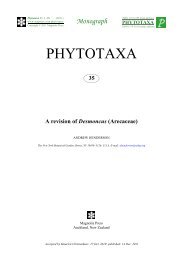Zootaxa, Taxonomy of Serpulidae (Annelida ... - Magnolia Press
Zootaxa, Taxonomy of Serpulidae (Annelida ... - Magnolia Press
Zootaxa, Taxonomy of Serpulidae (Annelida ... - Magnolia Press
Create successful ePaper yourself
Turn your PDF publications into a flip-book with our unique Google optimized e-Paper software.
Notochaetae <strong>of</strong> thoracic chaetigerous segments are usually termed simple capillary and narrow limbate<br />
(or hooded) chaetae in all serpulids and sabellids. Under the high magnification <strong>of</strong> a compound microscope a<br />
distal hood (or limbus) looks like a transparent finely striated blade structure (e.g., Fig. 33A, C). However,<br />
with SEM it is obvious that the limbus (or hood) in fact consists <strong>of</strong> a large number <strong>of</strong> fibers, more loosely<br />
packed than in the shaft, ending in tiny needle-shaped teeth (e.g., Figs 37A, 50A). Moreover, the usual<br />
thoracic chaetae (including collar chaetae, if any) are all limbate, but <strong>of</strong> two sizes: the smaller being called<br />
capillary, but clearly “limbate” as well. We have not specified this again in the generic diagnoses, and referred<br />
to them as “limbate”.<br />
In posterior thoracic segments (usually from the third backwards), these limbate chaetae (<strong>of</strong> two sizes) can<br />
be supplemented in some species by special chaetae termed “Apomatus” chaetae (Figs 10A, 11B, 12E, 14C,<br />
18C, 19B, 24C, 25A, 28B, 30C, 33B, 37E, 41A, 44B). These chaetae are typically sigmoid to sickle-shaped<br />
with a proximal denticulate zone (looking like fine striation under a compound microscope) and a long flat<br />
curved blade with a row <strong>of</strong> blunt regular teeth. In the spirorbin literature (e.g., Knight-Jones 1981) sigmoid<br />
chaetae <strong>of</strong> both thorax and abdomen are called “sickle-chaetae”. However, the proximal denticulate zone is an<br />
order <strong>of</strong> magnitude shorter in abdominal sigmoid chaetae; therefore we propose to restrict “sickle-chaetae” to<br />
abdominal chaetae, to discern them from the thoracic Apomatus chaetae. Sometimes these Apomatus chaetae<br />
are almost straight.<br />
The bundle <strong>of</strong> collar chaetae may contain special chaetae in addition to simple limbate ones. These special<br />
chaetae have a more-or-less distinct boss at the base <strong>of</strong> the distal limbate blade. Like the “hoods” <strong>of</strong> the<br />
limbate blades, the basal bosses are made <strong>of</strong> fibres, ending in tips forming teeth. Depending on the number<br />
and size <strong>of</strong> the teeth in the boss, four types <strong>of</strong> special collar chaetae have been distinguished in serpulids.<br />
1. Bayonet-type chaetae generally have one or two (sometimes more) large proximal bosses at the base <strong>of</strong> the<br />
distal limbate zone: Serpula (Fig. 46A), Spiraserpula, Crucigera (Fig. 13A), Hydroides (Fig. 23A), and<br />
Floriprotis (Fig. 20A), sometimes small auxiliary teeth present.<br />
2. Fin-and-blade chaetae have the basal boss (“fin”) made <strong>of</strong> relatively few teeth <strong>of</strong> intermediate size; the<br />
basal fin may or may not be separated by a toothless zone (a gap) from the distal blade: Chitinopoma (Fig.<br />
11A), Chitinopomoides (Fig. 12A), Filograna (Fig. 17A), Filogranula (Fig. 19A).<br />
3. Spirobranchus-type chaetae have a proximal boss consisting <strong>of</strong> very numerous tiny hair-like spines:<br />
Spirobranchus (Fig. 47A) and Laminatubus (Fig. 26A).<br />
4. Ficopomatus has unusual collar chaetae, with coarse curved teeth alongside the distal part <strong>of</strong> chaetae (Fig.<br />
16A).<br />
Thoracic uncini. The uncini are arranged side by side in a single row in a torus, transverse relative to the<br />
long axis <strong>of</strong> the body, with the dentate distal edge <strong>of</strong> the uncini directed anteriorly. Thoracic uncinigerous tori<br />
generally are positioned along the lateral side <strong>of</strong> the thorax, but in some taxa they are widely separated in<br />
front, gradually approaching one another posteriorly, so that the posterior thoracic tori may touch each other,<br />
forming a triangular depression on the ventral side <strong>of</strong> the thorax. In other taxa (e.g., Neovermilia globula)<br />
thoracic tori are completely shifted to the ventral part <strong>of</strong> the thorax. Some species <strong>of</strong> Protula may completely<br />
lack thoracic uncini (e.g., P. bispiralis and, occasionally, P. intestinum as well (Fauvel 1927)).<br />
Serpulid uncini are flattened comb-shaped structures with a number <strong>of</strong> curved teeth on their edge. Each<br />
uncinus in our view possesses four characters: 1) the number <strong>of</strong> teeth visible in pr<strong>of</strong>ile (from 4 to well over<br />
30); 2) the (maximum) number <strong>of</strong> teeth in a transverse row; 3) the shape <strong>of</strong> the anterior-most tooth (“fang” or<br />
“peg”); 4) overall shape <strong>of</strong> the edge <strong>of</strong> the uncinus. Depending on the number <strong>of</strong> vertical rows <strong>of</strong> teeth in the<br />
uncini they are termed saw-shaped (one row <strong>of</strong> teeth along the edge, e.g., thorax Hydroides), saw-to-raspshaped<br />
(from 1 tooth on edge distally to a row <strong>of</strong> 5 teeth proximally above the peg, e.g., Filogranula, dental<br />
formula P:5:3:3:2:1:1:1:1:1:1:1:1:1, Fig. 19C, Semivermilia) or rasp-shaped (several rows <strong>of</strong> teeth along the<br />
entire edge, e.g., Hyalopomatus) (ten Hove 1975, ten Hove & Wolf 1984). In some taxa, thoracic uncini<br />
normally have teeth in a single row (saw-shaped, e.g., Figs 23B, 38B, 46B). However, towards the end <strong>of</strong> a<br />
row uncini occasionally may change from saw-shaped to saw-to-rasp-shaped, in which case the distal tooth<br />
(teeth) may be single, while the teeth proximal to the fang may be in 2–3 rows or uncini even change to<br />
24 · <strong>Zootaxa</strong> 2036 © 2009 <strong>Magnolia</strong> <strong>Press</strong><br />
TEN HOVE & KUPRIYANOVA
















